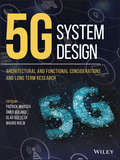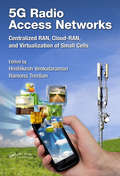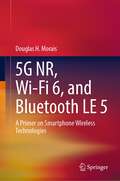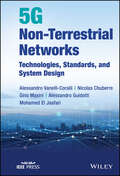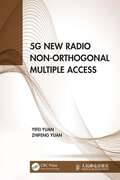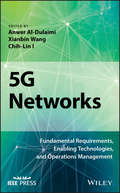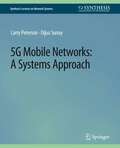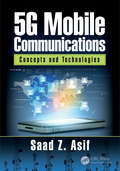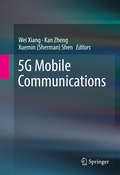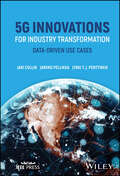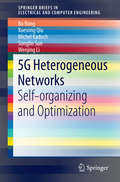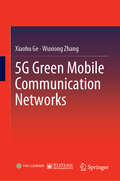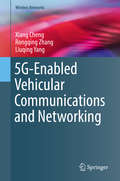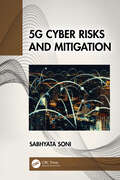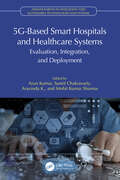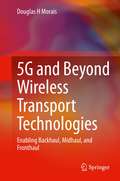- Table View
- List View
5G System Design: Architectural and Functional Considerations and Long Term Research
by Patrick Marsch 214 Mer Bulak 231 Olav Queseth Mauro BoldiThis book provides a comprehensive overview of the latest research and standardization progress towards the 5th generation (5G) of mobile communications technology and beyond. It covers a wide range of topics from 5G use cases and their requirements, to spectrum, 5G end-to-end (E2E) system architecture including core network (CN), transport network (TN) and radio access network (RAN) architecture, network slicing, security and network management. It further dives into the detailed functional design and the evaluation of different 5G concepts, and provides details on planned trials and pre-commercial deployments across the globe. While the book naturally captures the latest agreements in 3rd Generation Partnership Project (3GPP) New Radio (NR) Release 15, it goes significantly beyond this by describing the likely developments towards the final 5G system that will ultimately utilize a wide range of spectrum bands, address all envisioned 5G use cases, and meet or exceed the International Mobile Telecommunications (IMT) requirements for the year 2020 and beyond (IMT-2020). 5G System Design: Architectural and Functional Considerations and Long Term Research is based on the knowledge and consensus from 158 leading researchers and standardization experts from 54 companies or institutes around the globe, representing key mobile network operators, network vendors, academic institutions and regional bodies for 5G. Different from earlier books on 5G, it does not focus on single 5G technology components, but describes the full 5G system design from E2E architecture to detailed functional design, including details on 5G performance, implementation and roll-out.
5G System Design: Architectural and Functional Considerations and Long Term Research
by Patrick Marsch Ömer Bulakci Olav Queseth Mauro BoldiThis book provides a comprehensive overview of the latest research and standardization progress towards the 5th generation (5G) of mobile communications technology and beyond. It covers a wide range of topics from 5G use cases and their requirements, to spectrum, 5G end-to-end (E2E) system architecture including core network (CN), transport network (TN) and radio access network (RAN) architecture, network slicing, security and network management. It further dives into the detailed functional design and the evaluation of different 5G concepts, and provides details on planned trials and pre-commercial deployments across the globe. While the book naturally captures the latest agreements in 3rd Generation Partnership Project (3GPP) New Radio (NR) Release 15, it goes significantly beyond this by describing the likely developments towards the final 5G system that will ultimately utilize a wide range of spectrum bands, address all envisioned 5G use cases, and meet or exceed the International Mobile Telecommunications (IMT) requirements for the year 2020 and beyond (IMT-2020). 5G System Design: Architectural and Functional Considerations and Long Term Research is based on the knowledge and consensus from 158 leading researchers and standardization experts from 54 companies or institutes around the globe, representing key mobile network operators, network vendors, academic institutions and regional bodies for 5G. Different from earlier books on 5G, it does not focus on single 5G technology components, but describes the full 5G system design from E2E architecture to detailed functional design, including details on 5G performance, implementation and roll-out.
5G Radio Access Networks: Centralized RAN, Cloud-RAN and Virtualization of Small Cells
by Hrishikesh Venkataraman Ramona TrestianC-RAN and virtualized Small Cell technology poses several major research challenges. These include dynamic resource allocation, self-configuration in the baseband pool, high latency in data transfer between radio unit and baseband unit, the cost of data delivery, high volume of data in the network, software networking aspects, potential energy savings, security concerns, privacy of user’s personal data at a remote place, limitations of virtualized environment, etc. This book provides deeper insights into the next generation RAN architecture and surveys the coexistence of SDN, C-RAN and Small Cells solutions proposed in the literature at different levels.
5G NR, Wi-Fi 6, and Bluetooth LE 5: A Primer on Smartphone Wireless Technologies
by Douglas H MoraisThis book provides, at a high level and in a tractable fashion, a description of how wireless communications are achieved in the latest smartphones. The author shows how smartphones communicate via three separate systems, namely 5G NR, Wi-Fi 6, and Bluetooth Low Energy 5. He explains how 5G NR allows mobile voice and high-speed data communication, how Wi-Fi allows smartphone attachment to the Internet independent of 5G NR, and how Bluetooth allows smartphone attachment to speakers, in-car entertainment systems, smart watches, etc. This text explains the key basic technologies employed and then addresses how each system operates. This book is of interest to anyone with a rudimentary scientific understanding who desires to know more at an intuitive level rather than rigorous one how smartphones achieve wireless communications.
5G Non-Terrestrial Networks: Technologies, Standards, and System Design
by Alessandro Vanelli-Coralli Nicolas Chuberre Gino Masini Alessandro Guidotti Mohamed El Jaafari5G Non-Terrestrial Networks Provides a complete and detailed description of the non-terrestrial component in the 5G ecosystem 5G Non-Terrestrial Networks is the first multi-authored reference dedicated to the integration of non-terrestrial networks (NTN) into the 5G ecosystem. Written by leaders in the development of the 3GPP 5G NTN specification, this authoritative resource addresses all key aspects of non-terrestrial components of 5G systems, including standardization, architecture, protocols, and regulatory considerations. Drawing from their expertise in academic and industrial research and development, the authors introduce fundamental principles of non-terrestrial communications, define the NTN architecture and radio protocol stacks, describe applications to support mobility and radio resource management, and more. The book covers 5G New Radio-based technology for NTN as well as LTE NB-IoT/eMTC, providing a well-rounded understanding of the unique characteristics of 5G-NTN systems. Throughout the text, the authors offer insights on various design approaches, technical choices, and trade-off options. In addition, the book: Addresses the integration of non-terrestrial networks into 5G systems at all levels Describes the principles of non-terrestrial systems, including orbital parameters, link budget, propagation, and space/ground segments Includes a detailed overview of 5G-NTN system architectures, deployment scenarios, and spectrum aspects Covers NB-IoT and eMTC in NTN, NTN use cases, 5G QoS, and New Radio Discusses the potential of non-terrestrial components of 5G in the future 6G ecosystem 5G Non-Terrestrial Networks is a must-have for communication engineers, satellite network operators, aerospace and electrical engineers, network engineers, academic researchers and industry professionals involved in 5G infrastructure development, as well as advanced students taking courses on 5G and satellite communication.
5G Non-Terrestrial Networks: Technologies, Standards, and System Design
by Alessandro Vanelli-Coralli Nicolas Chuberre Gino Masini Alessandro Guidotti Mohamed El Jaafari5G Non-Terrestrial Networks Provides a complete and detailed description of the non-terrestrial component in the 5G ecosystem 5G Non-Terrestrial Networks is the first multi-authored reference dedicated to the integration of non-terrestrial networks (NTN) into the 5G ecosystem. Written by leaders in the development of the 3GPP 5G NTN specification, this authoritative resource addresses all key aspects of non-terrestrial components of 5G systems, including standardization, architecture, protocols, and regulatory considerations. Drawing from their expertise in academic and industrial research and development, the authors introduce fundamental principles of non-terrestrial communications, define the NTN architecture and radio protocol stacks, describe applications to support mobility and radio resource management, and more. The book covers 5G New Radio-based technology for NTN as well as LTE NB-IoT/eMTC, providing a well-rounded understanding of the unique characteristics of 5G-NTN systems. Throughout the text, the authors offer insights on various design approaches, technical choices, and trade-off options. In addition, the book: Addresses the integration of non-terrestrial networks into 5G systems at all levels Describes the principles of non-terrestrial systems, including orbital parameters, link budget, propagation, and space/ground segments Includes a detailed overview of 5G-NTN system architectures, deployment scenarios, and spectrum aspects Covers NB-IoT and eMTC in NTN, NTN use cases, 5G QoS, and New Radio Discusses the potential of non-terrestrial components of 5G in the future 6G ecosystem 5G Non-Terrestrial Networks is a must-have for communication engineers, satellite network operators, aerospace and electrical engineers, network engineers, academic researchers and industry professionals involved in 5G infrastructure development, as well as advanced students taking courses on 5G and satellite communication.
5G New Radio Non-Orthogonal Multiple Access
by Yifei Yuan Zhifeng YuanThis book provides detailed descriptions of downlink non-orthogonal multiple transmissions and uplink non-orthogonal multiple access (NOMA) from the aspects of majorly used 5G new radio scenarios and system performance. For the downlink, the discussion focuses on the candidate schemes in 3GPP standards which are not only applicable to unicast services but also to broadcast/multicast scenarios. For the uplink, the main target scenario is massive machine-type communications where grant-free transmission can reduce signaling overhead, power consumption of devices and access delays. The design principles of several uplink NOMA schemes are discussed in-depth, together with the analysis of their performances and receiver complexities. Devoted to the basic technologies of NOMA and its theoretical principles, data analysis, basic algorithms, evaluation methodology and simulation results, this book will be an essential read for researchers and students of digital communications, wireless communications engineers and those who are interested in mobile communications in general.
5G New Radio Non-Orthogonal Multiple Access
by Yifei Yuan Zhifeng YuanThis book provides detailed descriptions of downlink non-orthogonal multiple transmissions and uplink non-orthogonal multiple access (NOMA) from the aspects of majorly used 5G new radio scenarios and system performance. For the downlink, the discussion focuses on the candidate schemes in 3GPP standards which are not only applicable to unicast services but also to broadcast/multicast scenarios. For the uplink, the main target scenario is massive machine-type communications where grant-free transmission can reduce signaling overhead, power consumption of devices and access delays. The design principles of several uplink NOMA schemes are discussed in-depth, together with the analysis of their performances and receiver complexities. Devoted to the basic technologies of NOMA and its theoretical principles, data analysis, basic algorithms, evaluation methodology and simulation results, this book will be an essential read for researchers and students of digital communications, wireless communications engineers and those who are interested in mobile communications in general.
5G Networks: Fundamental Requirements, Enabling Technologies, and Operations Management (Ieee Press Series On Vehicular Technology Ser.)
by Anwer Al-Dulaimi Xianbin Wang Chih-Lin IA reliable and focused treatment of the emergent technology of fifth generation (5G) networks This book provides an understanding of the most recent developments in 5G, from both theoretical and industrial perspectives. It identifies and discusses technical challenges and recent results related to improving capacity and spectral efficiency on the radio interface side, and operations management on the core network side. It covers both existing network technologies and those currently in development in three major areas of 5G: spectrum extension, spatial spectrum utilization, and core network and network topology management. It explores new spectrum opportunities; the capability of radio access technology; and the operation of network infrastructure and heterogeneous QoE provisioning. 5G Networks: Fundamental Requirements, Enabling Technologies, and Operations Management is split into five sections: Physical Layer for 5G Radio Interface Technologies; Radio Access Technology for 5G Networks; 5G Network Interworking and Core Network Advancements; Vertical 5G Applications; and R&D and 5G Standardization. It starts by introducing emerging technologies in 5G software, hardware, and management aspects before moving on to cover waveform design for 5G and beyond; code design for multi-user MIMO; network slicing for 5G networks; machine type communication in the 5G era; provisioning unlicensed LAA interface for smart grid applications; moving toward all-IT 5G end-to-end infrastructure; and more. This valuable resource: Provides a comprehensive reference for all layers of 5G networks Focuses on fundamental issues in an easy language that is understandable by a wide audience Includes both beginner and advanced examples at the end of each section Features sections on major open research challenges 5G Networks: Fundamental Requirements, Enabling Technologies, and Operations Management is an excellent book for graduate students, academic researchers, and industry professionals, involved in 5G technology.
5G Networks: Fundamental Requirements, Enabling Technologies, and Operations Management
by Anwer Al-Dulaimi Xianbin Wang I. Chih-LinA reliable and focused treatment of the emergent technology of fifth generation (5G) networks This book provides an understanding of the most recent developments in 5G, from both theoretical and industrial perspectives. It identifies and discusses technical challenges and recent results related to improving capacity and spectral efficiency on the radio interface side, and operations management on the core network side. It covers both existing network technologies and those currently in development in three major areas of 5G: spectrum extension, spatial spectrum utilization, and core network and network topology management. It explores new spectrum opportunities; the capability of radio access technology; and the operation of network infrastructure and heterogeneous QoE provisioning. 5G Networks: Fundamental Requirements, Enabling Technologies, and Operations Management is split into five sections: Physical Layer for 5G Radio Interface Technologies; Radio Access Technology for 5G Networks; 5G Network Interworking and Core Network Advancements; Vertical 5G Applications; and R&D and 5G Standardization. It starts by introducing emerging technologies in 5G software, hardware, and management aspects before moving on to cover waveform design for 5G and beyond; code design for multi-user MIMO; network slicing for 5G networks; machine type communication in the 5G era; provisioning unlicensed LAA interface for smart grid applications; moving toward all-IT 5G end-to-end infrastructure; and more. This valuable resource: Provides a comprehensive reference for all layers of 5G networks Focuses on fundamental issues in an easy language that is understandable by a wide audience Includes both beginner and advanced examples at the end of each section Features sections on major open research challenges 5G Networks: Fundamental Requirements, Enabling Technologies, and Operations Management is an excellent book for graduate students, academic researchers, and industry professionals, involved in 5G technology.
5G Mobile Networks: A Systems Approach (Synthesis Lectures on Network Systems)
by Larry PetersonThis book describes the 5G mobile network from a systems perspective, focusing on the fundamental design principles that are easily obscured by an overwhelming number of acronyms and standards definitions that dominate this space. The book is written for system generalists with the goal of helping bring up to speed a community that understands a broad range of systems issues (but knows little or nothing about the cellular network) so it can play a role in the network's evolution. This is a community that understands both feature velocity and best practices in building robust scalable systems, and so it has an important role to play in bringing to fruition all of 5G's potential. In addition to giving a step-by-step tour of the design rationale behind 5G, the book aggressively disaggregates the 5G mobile network. Building a disaggregated, virtualized, and software-defined 5G access network is the direction the industry is already headed (for good technical and business reasons), but breaking the 5G network down into its elemental components is also the best way to explain how 5G works. It also helps to illustrate how 5G might evolve in the future to provide even more value. An open source implementation of 5G serves as the technical underpinning for the book. The authors, in collaboration with industrial and academic partners, are working towards a cloud-based implementation that takes advantage of both Software-Defined Networking (SDN) and cloud-native (microservice-based) architectures, culminating in a managed 5G-enabled EdgeCloud-as-a-Service built on the components and mechanisms described throughout the book.
5G Mobile Communications: Concepts and Technologies
by Saad AsifThis book will help readers comprehend technical and policy elements of telecommunication particularly in the context of 5G. It first presents an overview of the current research and standardization practices and lays down the global frequency spectrum allocation process. It further lists solutions to accommodate 5G spectrum requirements. The readers will find a considerable amount of information on 4G (LTE-Advanced), LTE-Advance Pro, 5G NR (New Radio); transport network technologies, 5G NGC (Next Generation Core), OSS (Operations Support Systems), network deployment and end-to-end 5G network architecture. Some details on multiple network elements (end products) such as 5G base station/small cells and the role of semiconductors in telecommunication are also provided. Keeping trends in mind, service delivery mechanisms along with state-of-the-art services such as MFS (mobile financial services), mHealth (mobile health) and IoT (Internet-of-Things) are covered at length. At the end, telecom sector’s burning challenges and best practices are explained which may be looked into for today’s and tomorrow’s networks. The book concludes with certain high level suggestions for the growth of telecommunication, particularly on the importance of basic research, departure from ten-year evolution cycle and having a 20–30 year plan. Explains the conceivable six phases of mobile telecommunication’s ecosystem that includes R&D, standardization, product/network/device & application development, and burning challenges and best practices Provides an overview of research and standardization on 5G Discusses solutions to address 5G spectrum requirements while describing the global frequency spectrum allocation process Presents various case studies and policies Provides details on multiple network elements and the role of semiconductors in telecommunication Presents service delivery mechanisms with special focus on IoT
5G Mobile Communications
by Wei Xiang Kan Zheng Xuemin Sherman ShenThis book provides a comprehensive overview of the emerging technologies for next-generation 5G mobile communications, with insights into the long-term future of 5G. Written by international leading experts on the subject, this contributed volume covers a wide range of technologies, research results, and networking methods. Key enabling technologies for 5G systems include, but are not limited to, millimeter-wave communications, massive MIMO technology and non-orthogonal multiple access.5G will herald an even greater rise in the prominence of mobile access based upon both human-centric and machine-centric networks. Compared with existing 4G communications systems, unprecedented numbers of smart and heterogeneous wireless devices will be accessing future 5G mobile systems. As a result, a new paradigm shift is required to deal with challenges on explosively growing requirements in mobile data traffic volume (1000x), number of connected devices (10–100x), typical end-user data rate (10–100x), and device/network lifetime (10x). Achieving these ambitious goals calls for revolutionary candidate technologies in future 5G mobile systems. Designed for researchers and professionals involved with networks and communication systems, 5G Mobile Communications is a straightforward, easy-to-read analysis of the possibilities of 5G systems.
5G Innovations for Industry Transformation: Data-driven Use Cases
by Jari Collin Jarkko Pellikka Jyrki T. Penttinen5G INNOVATIONS FOR INDUSTRY TRANSFORMATION Authoritative resource providing insight on real-life industrial 5G use cases in driving customer value, productivity, and sustainability ambitions With 5G innovations rapidly expanding to different areas within technology, 5G Innovations for Industry Transformation provides key information on how 5G technology can positively impact digital transformation in the industry sectors, discussing new data-driven business opportunities, including green digital transition, new standards for sustainability, and real-time data-driven services, introducing case studies that cover a variety of industries, from the oil & gas industry to the telecom industry, along with the lessons learned from these case studies, and providing insights into how 5G technology will transform businesses by sharing real-time customer solutions, fair data sharing principles, and ecosystem and change management. The book summarizes novelty aspects in a compact and practical way to benefit users and specialists in the field who want to understand some of the very key aspects of 5G. To aid in reader comprehension, the book contains tables, figures of technical principles and architectural block diagrams, and photographs further explaining key topics. Sample topics covered in 5G Innovations for Industry Transformation include: 5G SA technology with new capabilities, 5G private networks, and how smart, connected products are transforming competition Implications of 5G applied to your particular business and/or industry, and how to scale up and industrialize based on these implications How to lead the charge in relation to optimizing business practices based on the advent of 5G, and details on navigating the platform economy How 5G affects data privacy and security, and other integrated capabilities of 5G, such as processes, data, technology, and competencies Based on real-world experiences and high-quality research and presenting practical examples that serve as a useful guiding hand, 5G Innovations for Industry Transformation is an essential resource for change leaders, enterprise architects, and software developers of any industrial enterprise seeking to drive digitalization forward in their value chain and organization.
5G Innovations for Industry Transformation: Data-driven Use Cases
by Jari Collin Jarkko Pellikka Jyrki T. Penttinen5G INNOVATIONS FOR INDUSTRY TRANSFORMATION Authoritative resource providing insight on real-life industrial 5G use cases in driving customer value, productivity, and sustainability ambitions With 5G innovations rapidly expanding to different areas within technology, 5G Innovations for Industry Transformation provides key information on how 5G technology can positively impact digital transformation in the industry sectors, discussing new data-driven business opportunities, including green digital transition, new standards for sustainability, and real-time data-driven services, introducing case studies that cover a variety of industries, from the oil & gas industry to the telecom industry, along with the lessons learned from these case studies, and providing insights into how 5G technology will transform businesses by sharing real-time customer solutions, fair data sharing principles, and ecosystem and change management. The book summarizes novelty aspects in a compact and practical way to benefit users and specialists in the field who want to understand some of the very key aspects of 5G. To aid in reader comprehension, the book contains tables, figures of technical principles and architectural block diagrams, and photographs further explaining key topics. Sample topics covered in 5G Innovations for Industry Transformation include: 5G SA technology with new capabilities, 5G private networks, and how smart, connected products are transforming competition Implications of 5G applied to your particular business and/or industry, and how to scale up and industrialize based on these implications How to lead the charge in relation to optimizing business practices based on the advent of 5G, and details on navigating the platform economy How 5G affects data privacy and security, and other integrated capabilities of 5G, such as processes, data, technology, and competencies Based on real-world experiences and high-quality research and presenting practical examples that serve as a useful guiding hand, 5G Innovations for Industry Transformation is an essential resource for change leaders, enterprise architects, and software developers of any industrial enterprise seeking to drive digitalization forward in their value chain and organization.
5G Heterogeneous Networks: Self-organizing and Optimization (SpringerBriefs in Electrical and Computer Engineering)
by Bo Rong Xuesong Qiu Michel Kadoch Songlin Sun Wenjing LiThis SpringerBrief provides state-of-the-art technical reviews on self-organizing and optimization in 5G systems. It covers the latest research results from physical-layer channel modeling to software defined network (SDN) architecture. This book focuses on the cutting-edge wireless technologies such as heterogeneous networks (HetNets), self-organizing network (SON), smart low power node (LPN), 3D-MIMO, and more. It will help researchers from both the academic and industrial worlds to better understand the technical momentum of 5G key technologies.
5G Green Mobile Communication Networks
by Xiaohu Ge Wuxiong ZhangThis book focuses on the modeling, optimization, and applications of 5G green mobile communication networks, aimed at improving energy efficiency and spectrum utilization in 5G systems. It offers a balance between theoretical analysis and engineering practice, providing in-depth studies of a number of major topics, such as energy consumption models, optimization, system design, implementation, and performance evaluation. It also discusses four aspects of green communication in detail: cellular networks, resource management, wireless transmissions and multi-media communications. Further, this unique book comprehensively and systematically discusses green optimization in wireless mobile communications. As such it is a valuable resource for researchers, engineers, and graduate students in various fields, including telecommunications engineering, electrical and electronic engineering, and computer engineering, particularly those interested in green communications.
5G-Enabled Vehicular Communications and Networking (Wireless Networks)
by Xiang Cheng Rongqing Zhang Liuqing YangThis book investigates and reviews recent advanced techniques and important applications in vehicular communications and networking (VCN) from a novel perspective of the combination and integration of VCN and connected vehicles, which provides a significant scientific and technical support for future 5G-based VCN.5G-Enabled Vehicular Communications and Networking introduces vehicular channel characteristics, reviews current channel modeling approaches, and then provides a new generic geometry-based stochastic modeling approach for vehicle-to-everything (V2X) communications. The investigation of vehicular channel measurements and modeling provides fundamental supports for the VCN system design. Then, this book investigates VCN-vehicle combination from PHY and MAC layers, respectively. As for the PHY layer, many advanced techniques that can be effectively applied in VCN to counter the PHY challenges are introduced, including novel ICI cancellation methods, index modulated OFDM, differential spatial modulation, and energy harvesting relaying. As for the MAC layer, distributed and centralized MAC designs are analyzed and compared in terms of feasibility and availability. Specifically, distributed congestion control, D2D-enabled vehicular communications, and centralized data dissemination scheduling are elaborated, which can significantly improve the network performance in vehicular networks. Finally, considering VCN-vehicle integration, this book introduces several hot-topic applications in vehicular networks, including electric vehicles, distributed data storage, unmanned aerial vehicles, and security and privacy, which indicates the significance and development value of VCN-vehicle integration in future vehicular networks and our daily life. The primary audience for this book includes professionals and researchers working in the field of vehicular communications, intelligent transportation systems (ITS), and Internet of vehicles (IoV). Advanced level students studying electrical engineering will also find this book useful as a secondary textbook for related courses.
5G Cyber Risks and Mitigation
by Sabhyata Soni5 G technology is the next step in the evolution of wireless communication. It offers faster speeds and more bandwidth than 4G. One of the biggest differences between 4G and 5G is that 5G will be used for a wider range of applications. This makes it ideal for applications such as autonomous vehicles, smart cities, and the internet of things. This means that there will be more devices connected to 5G networks, making them more vulnerable to cyber attacks. However, 5 G also introduces new cyber risks that need to be addressed. In addition, 5 G networks are expected to be much more complex, making them harder to secure. 5G networks will use new technologies that could make them more vulnerable to attack. These technologies include massive MIMO (multiple input, multiple output), which uses more antennas than traditional cellular networks, and millimeter wave (mmWave), which uses higher frequencies than traditional cellular networks. These new technologies could make it easier for attackers to intercept data or disrupt service. To address these concerns, security measures must be implemented throughout the network. Security mechanisms must be included in the design of 5G networks and must be updated as new threats are identified. Moreover, to address these risks, 5 G security standards need to be developed and implemented. These standards should include measures to protect against Denial of Service (DoS) attacks, malware infections, and other threats. Fortunately, artificial intelligence can play a key role in mitigating these risks. With so many interconnected devices, it can be difficult to identify and isolate malicious traffic. AI can help by identifying patterns in data that would otherwise be undetectable to humans. 6G technology is still in the early developmental stages, but security experts are already voicing concerns about the potential challenges that could arise with this next generation of mobile connectivity. Experts are already working on a roadmap for 6G deployment, and they are confident that these and other challenges can be overcome.
5G Cyber Risks and Mitigation
by Sabhyata Soni5 G technology is the next step in the evolution of wireless communication. It offers faster speeds and more bandwidth than 4G. One of the biggest differences between 4G and 5G is that 5G will be used for a wider range of applications. This makes it ideal for applications such as autonomous vehicles, smart cities, and the internet of things. This means that there will be more devices connected to 5G networks, making them more vulnerable to cyber attacks. However, 5 G also introduces new cyber risks that need to be addressed. In addition, 5 G networks are expected to be much more complex, making them harder to secure. 5G networks will use new technologies that could make them more vulnerable to attack. These technologies include massive MIMO (multiple input, multiple output), which uses more antennas than traditional cellular networks, and millimeter wave (mmWave), which uses higher frequencies than traditional cellular networks. These new technologies could make it easier for attackers to intercept data or disrupt service. To address these concerns, security measures must be implemented throughout the network. Security mechanisms must be included in the design of 5G networks and must be updated as new threats are identified. Moreover, to address these risks, 5 G security standards need to be developed and implemented. These standards should include measures to protect against Denial of Service (DoS) attacks, malware infections, and other threats. Fortunately, artificial intelligence can play a key role in mitigating these risks. With so many interconnected devices, it can be difficult to identify and isolate malicious traffic. AI can help by identifying patterns in data that would otherwise be undetectable to humans. 6G technology is still in the early developmental stages, but security experts are already voicing concerns about the potential challenges that could arise with this next generation of mobile connectivity. Experts are already working on a roadmap for 6G deployment, and they are confident that these and other challenges can be overcome.
5G-Based Smart Hospitals and Healthcare Systems: Evaluation, Integration, and Deployment (Advancements in Intelligent and Sustainable Technologies and Systems)
by Arun Kumar Sumit Chakravarty K. Aravinda Mohit Kumar SharmaWith the increase in the development of the advanced cellular communication system, it is assumed that several sectors, such as the health industry, education, transport industry, business model, and so on, will rapidly grow. However, the requirements of the above-mentioned sectors are different and difficult to fulfill. Hence, 5G will be integral to several networks and will also need a unique management system for its successful rollout around the globe. 5G-Based Smart Hospitals and Healthcare Systems: Evaluation, Integration, and Deployment provides an overview of the role of advanced technologies in transforming the healthcare industry. It emphasizes the technical requirements of smart hospitals and the technologies associated with them along with explaining how technologies such as IoT, machine learning, and AI can be integrated with smart hospitals and 5G networks. The book evaluates several concerns such as privacy of data, infrastructure costs, and regular upgradability of technologies. Since the storage of information is a major concern with the implantation of 5G-based hospitals, this book will specifically address those issues along with examining the potential pitfalls of 5G-based hospitals and the factors that cause their failures. This book specifically targets professionals, academicians, engineers, researchers, management firms, technical institutes, R&D establishments, and individuals researching in the fields of 5G, healthcare, medical sensors, IoT, big data, and related fields. The main objectives of this book are to accumulate state-of-the-art IoT, 5G, AI, and machine learning-based approaches for resolving healthcare problems.
5G-Based Smart Hospitals and Healthcare Systems: Evaluation, Integration, and Deployment (Advancements in Intelligent and Sustainable Technologies and Systems)
With the increase in the development of the advanced cellular communication system, it is assumed that several sectors, such as the health industry, education, transport industry, business model, and so on, will rapidly grow. However, the requirements of the above-mentioned sectors are different and difficult to fulfill. Hence, 5G will be integral to several networks and will also need a unique management system for its successful rollout around the globe. 5G-Based Smart Hospitals and Healthcare Systems: Evaluation, Integration, and Deployment provides an overview of the role of advanced technologies in transforming the healthcare industry. It emphasizes the technical requirements of smart hospitals and the technologies associated with them along with explaining how technologies such as IoT, machine learning, and AI can be integrated with smart hospitals and 5G networks. The book evaluates several concerns such as privacy of data, infrastructure costs, and regular upgradability of technologies. Since the storage of information is a major concern with the implantation of 5G-based hospitals, this book will specifically address those issues along with examining the potential pitfalls of 5G-based hospitals and the factors that cause their failures. This book specifically targets professionals, academicians, engineers, researchers, management firms, technical institutes, R&D establishments, and individuals researching in the fields of 5G, healthcare, medical sensors, IoT, big data, and related fields. The main objectives of this book are to accumulate state-of-the-art IoT, 5G, AI, and machine learning-based approaches for resolving healthcare problems.
5G and Next-Gen Consumer Banking Services
by Krunoslav Ris, PhDThe future has already begin. The banking industry needs to adjust, or it will disappear in the next decade. With the help of 5G, next-generation intelligent ATM-like devices will have highly integrated functions and use technologies such as artificial intelligences-assisted self-service contactless interfaces with facial recognition and digital signatures. This book focuses on new experiences that clients can expect when connected to a 5G network with a 5G device. By 2022 we hope that 5G will: Drive accelerated mBanking growth Power augmented reality /virtual reality Make Video shopping experiences more widespread and compelling Enable banks to deploy highly personalized customer service experiences Support time-sensitive banking applications, like online stock trading where milliseconds can determine a gain or loss Improve security and fraud prevention bycomputing and exchanging more data traveling between parties in real-time Enhance mPOS transactions and utilization. 5G holds the potential to accelerate mobile point of sale (MPOS) transaction processing time and improve connectivity In order to explore these topics, this book covers: • Decentralization of the banks • Banking without banks • 5G will change the modern banking industry • Blockchain adoption by the banking industry
5G and Next-Gen Consumer Banking Services
by Krunoslav Ris, PhDThe future has already begin. The banking industry needs to adjust, or it will disappear in the next decade. With the help of 5G, next-generation intelligent ATM-like devices will have highly integrated functions and use technologies such as artificial intelligences-assisted self-service contactless interfaces with facial recognition and digital signatures. This book focuses on new experiences that clients can expect when connected to a 5G network with a 5G device. By 2022 we hope that 5G will: Drive accelerated mBanking growth Power augmented reality /virtual reality Make Video shopping experiences more widespread and compelling Enable banks to deploy highly personalized customer service experiences Support time-sensitive banking applications, like online stock trading where milliseconds can determine a gain or loss Improve security and fraud prevention bycomputing and exchanging more data traveling between parties in real-time Enhance mPOS transactions and utilization. 5G holds the potential to accelerate mobile point of sale (MPOS) transaction processing time and improve connectivity In order to explore these topics, this book covers: • Decentralization of the banks • Banking without banks • 5G will change the modern banking industry • Blockchain adoption by the banking industry
5G and Beyond Wireless Transport Technologies: Enabling Backhaul, Midhaul, and Fronthaul
by Douglas H MoraisThis text covers the key technologies employed in wireless links that enable increased data rates and thus are likely to be employed in support of 5G wireless transport networks, i.e., backhaul, midhaul, and fronthaul networks. The author presents technologies at an introductory level but nonetheless at a level that imparts to the reader a sound understanding of the fundamentals. The book is intended for those practicing engineers and graduate and upper undergraduate students who have an interest in acquiring, where missing, the necessary technology background in order to comprehend the functioning and capability of 5G based wireless transport links. The author focuses on those technologies that are key to achieving the high data rates and high reliability required of this transport. The material is presented in a clear, concise, and mathematically light fashion.Covers key wireless transport (backhaul, midhaul, and fronthaul) technologies for 5G and beyond, presented in a clear tractable fashion;Outlines the basic wireless transport transmitter/receiver terminal architecture, provides specifications of some such terminals, and indicates the link performance afforded by such terminals;Provides sufficient mathematics to make it technically coherent, but not so much as to make it challenging for a reader with no or limited familiarity with these technologies.
